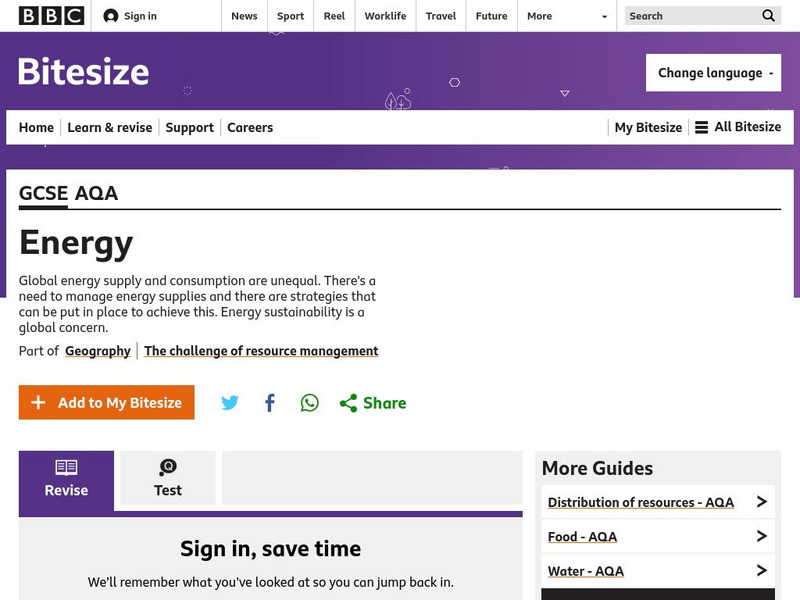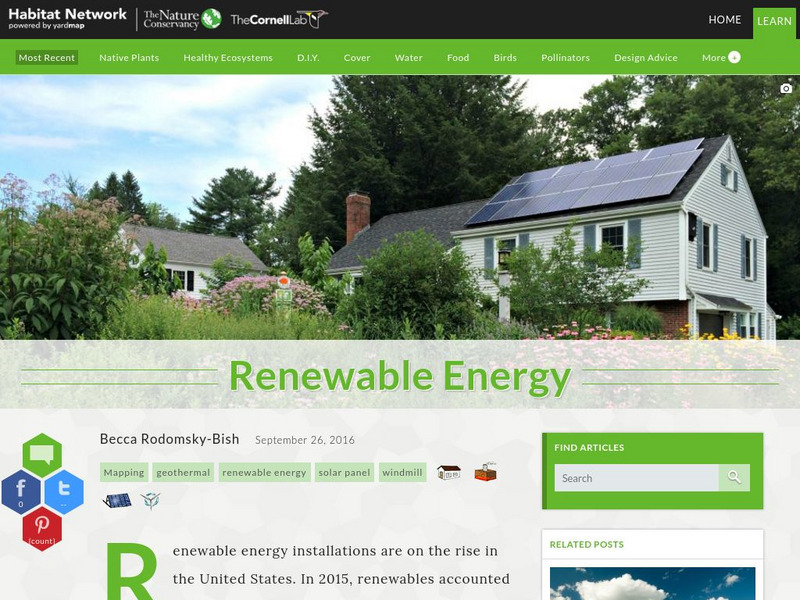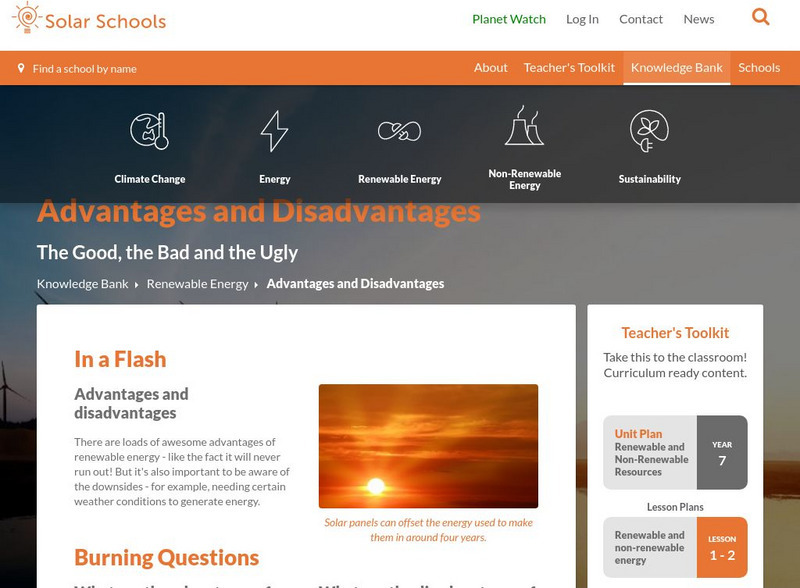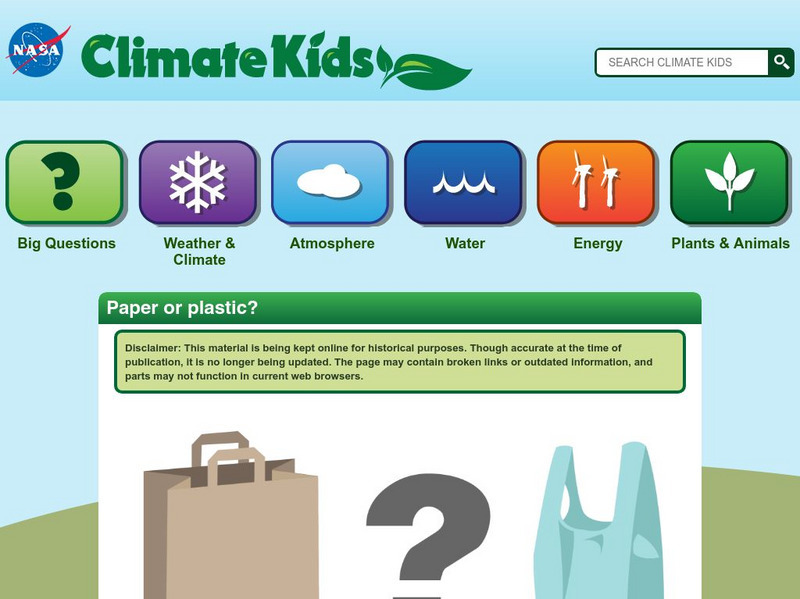NASA
From Smoke Signals to Cell Phones: Tracing How Technologies Evolve
Explore the science of space exploration. Pupils consider technological advances in propulsion, communication, power, navigation, and imaging. They select one of these areas and create a timeline of historical progress that contributed...
Khan Academy
Khan Academy: Energy Through Time
The quest for energy has always been a balancing act. As humans have gained greater control over their environment, they've found abundant resources - and faced numerous challenges. This article traces the history of our quest for energy.
Biotechnology Institute
Biotechnology Institute: Your World: Biofuels: Energy for Your Future [Pdf]
Students can read this full-length download of the biotech magazine which discusses how biofuels could be the energy of the future, and meet all our energy needs.
BBC
Bbc: Energy
Renewable resources quickly replinish themselves and can be used again and again. For this reason they are sometimes called infinite energy resources.
Other
Rew: Us Energy Department Funds Low Carbon Jet Fuel Demonstration Plant
An approval from the U.S. Energy Department will financially allow further development and testing of low-carbon fuel.
Cornell Lab of Ornithology
Habitat Network: Renewable Energy
Find out about efforts to promote the use of renewable energy sources by homeowners and businesses. This was a project where homeowners could submit data about what they were doing to use renewable energy sources. The site is no longer...
NASA
Nasa: Climate Kids: Huge Machine Harnesses the Tides
Learn how an alternative energy source called tidal energy works, and find out where it is being harnessed.
NOAA
Noaa: Weather Systems and Patterns
Imagine our weather if Earth were completely motionless, had a flat dry landscape and an un-tilted axis. This, of course, is not the case; if it were, the weather would be much different. The local weather that impacts our daily lives...
Other
Technology Resources: Resources Are Things We Need to Get a Job Done [Pdf]
Resources are things we need to get a job done. Every technological system makes use of seven types of resources: people, information, materials, tools and machines, energy, capital, and time.
Energy for Sustainable Development
Kids and Energy: Hydro Energy
Hydropower is a clean, renewable and reliable energy source which converts kinetic energy from falling water into electricity, without consuming more water than is produced by nature. Quite simply the oldest method by which renewable...
Peace Corps
Peace Corps: Bolivia, When Success Is Truly Sweet
In Spanish. The energy and motivation of Bolivians towards caring for their environment and wanting to improve their economy is detailed here with a popular fruit crop.
Other
Solar Schools: The Advantages and Disadvantages of Renewable Energy
One major advantage with the use of renewable energy is that as it is renewable it is therefore sustainable and so will never run out. Renewable energy facilities generally require less maintenance than traditional generators. Their fuel...
Other
Conserve Energy Future: What Is Soil Pollution?
Students learn about the natural resource, soil, and explore the ways it can become polluted.
Other
The Sustainable Scale Project: Ecological Footprint
The Ecological Footprint is rooted in the fact that all renewable resources come from the earth. It accounts for the flows of energy and matter to and from any defined economy and converts these into the corresponding land/water area...
PBS
Pbs Learning Media: Einstein: How Smart Was He?
This essay from the NOVA Web site explores the impact Einstein made on physics and most everything we know about the cosmos.
DOGO Media
Dogo News: The North Dakota Access Pipeline
The NDAP has many people upset, but those most upset are the Standing Rock Sioux Tribe and environmentalists. Understand what the problem is with this underground pipeline. Find comprehension questions and vocabulary identification.
Other
Nrdc: Composting Is Way Easier Than You Think
The NRDC breaks down how to easily achieve at-home composting. Find out what can and cannot be composted.
Other
Skidmore College: Lifestyle Project
A copy of an article published in the Journal of Geoscience Education. It describes how the Lifestyle Project got started, and how it is used with students to help them develop an awareness of how their daily habits and actions have an...
Other
Few: Human Impact on the Environment & Environmental Impact on Humans
Human beings have an enormous impact on the natural environment, and ultimately on each other. The way we chose to house, clothe, shelter, and meet the needs for vital resources such as food, energy, and water, not only affect the...
Other
Allerin: How Green Robots Are Helping With Environmental Sustainability
Robots are now being used to fight climate change and protect our green environments. They help to fight forest fires, manage our waste, restore the oceans, support renewable energy initiatives, and make agriculture more-environmentally...
University of Alaska
Alaska Science Forum: Daniel Fahrenheit, Anders Celsius Left Their Marks
This resource provides an account of the lives of the two scientists responsible for two of the most common temperature scales. Includes biographical information about each and a description of how each developed their own temperature...
NASA
Climate Kids: Paper or Plastic?
Have you ever been in the grocery store and you were asked for paper or plastic? Discover the pros and cons of either choice, and then ultimately decide which might be the best.
PBS
Pbs Learning Media: Is Lactic Acid a Four Letter Word?
This essay by exercise physiologist Patti Finke and fitness consultant Warren Finke describes the process by which our bodies transform food energy into energy that our cells can use.
Other
Earth Day Canada: Eco Kids: Limit Food Waste
Each year, people throw out millions of tons of food that could still be eaten. That is a lot of food! Even when we compost food waste there are still some negative impacts. Resources like water and energy are used to grow and transport...


![Biotechnology Institute: Your World: Biofuels: Energy for Your Future [Pdf] Article Biotechnology Institute: Your World: Biofuels: Energy for Your Future [Pdf] Article](https://static.lp.lexp.cloud/images/attachment_defaults/resource/large/FPO-knovation.png)










